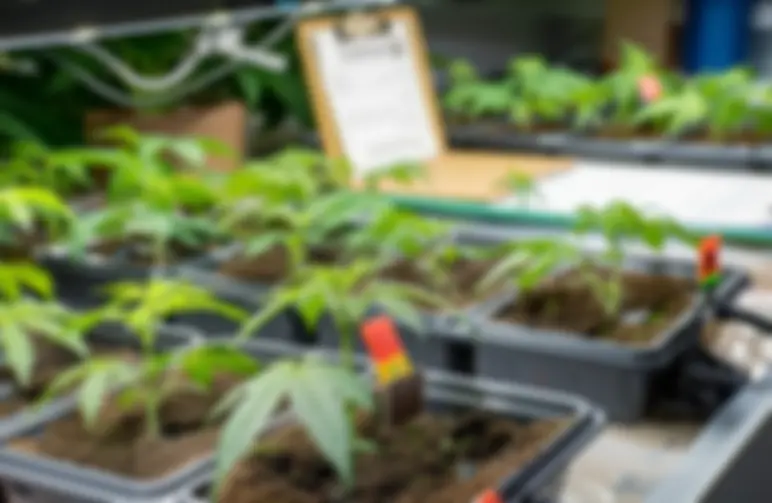Here’s another fresh study that growers will appreciate. Published in Scientific Reports (2025), Dilena and colleagues tested how nitrogen fertilization and clone genetics affect biomass and cannabinoid yields in a CBD-dominant cultivar called ‘Tas1’. The big takeaway: 160 mg/L nitrogen delivered the highest flower and CBD yield, while some clones consistently produced more cannabinoids regardless of nitrogen level. In practical terms, this means you can fine-tune feeding and clone selection to push yields without crossing legal THC limits.
Why nitrogen matters for cannabis
Every grower knows nitrogen (N) fuels leaf and stem growth. But too much N during flowering can dilute cannabinoid concentration, while too little limits biomass. Past research has been inconsistent, some trials suggested 50 mg/L is enough, others pointed to 160 mg/L. This Tasmanian trial set out to settle the debate by looking at both fertilization rates and clonal variation in the same CBD cultivar.
Study design in plain grower terms
- Genetics: Five clones taken from different mother plants of the cultivar ‘Tas1’, a CBD-rich, low-THC type.
- Fertilizer treatments: 30, 90, 160, 240, and 400 mg/L nitrogen, applied during the entire 8-week flowering period.
- Environment: Controlled glasshouse in Tasmania with LED lighting (18/6 veg, then 12/12 flower), drip irrigation, and 35L grow bags.
- Measurements: Dry biomass (leaves, upper and lower flowers), tissue nitrogen percentage, CBD and THC concentration (HPLC analysis).
- Complication: Some pollen contamination occurred, but seed weight averaged under 5% of biomass and didn’t affect cannabinoid results.
Key findings that growers should note
- Optimal nitrogen = 160 mg/L. Flower biomass climbed steadily up to 160 mg/L N, then plateaued. Leaves kept bulking with higher N, but flowers did not.
- CBD yield peaked at 27 g per plant at 160 mg/L N, equal to about 24 g/m² in this trial’s density. This was nearly double the yield at 30 mg/L.
- THC stayed low. Higher nitrogen reduced THC concentration faster than CBD, pushing the CBD:THC ratio upward, an advantage for staying under regulatory thresholds.
- Clone differences were real. Clones 13 and 27 produced significantly higher cannabinoid concentrations (CBD and THC) than clones 18 and 26, no matter the nitrogen rate. Biomass, however, was not influenced by clone ID.
- Leaf vs. flower responses differed. Leaf N% rose almost linearly with fertilization, while flower N% leveled off after 160 mg/L. Cannabinoid concentrations dropped as N% increased, a classic “dilution effect.”
- CBD:THC ratio increased with nitrogen. Especially in leaves and whole-plant averages, more N meant proportionally more CBD compared to THC.
How to use this information in your grow
- Dial in nitrogen at 160 mg/L. This is the sweet spot for maximizing biomass and CBD yield in ‘Tas1’ without wasting fertilizer or suppressing cannabinoids.
- Go easy beyond 160. Pushing to 240 or 400 mg/L did not increase flower mass and further reduced cannabinoid concentration. The plants kept building leaves, not more usable flower.
- Select proven clones. Even within the same cultivar, clone origin mattered. If you can track clone lines, favor those with consistent cannabinoid expression (in this trial, 13 and 27 outperformed others).
- Use fertilization to manage THC risk. Since THC dropped faster than CBD at higher N rates, nitrogen can be a compliance tool to keep THC below thresholds while still boosting CBD.
- Watch for dilution effects. Stronger feeding grows bigger plants, but cannabinoid % by weight often falls. Yield per plant may still increase because biomass gains outweigh concentration losses.
Fast grower FAQs
What’s the best nitrogen rate?
Around 160 mg/L N during flowering gave the best combination of biomass and CBD yield. More N only fed leaves, not flowers.
Can I push harder with nitrogen to lower THC?
Yes, but with caution. THC concentration declined more than CBD with higher N, raising the CBD:THC ratio. However, flower yield didn’t increase past 160 mg/L.
Do clones really make a difference?
Absolutely. In this trial, cannabinoid content varied by up to 3% CBD between clones from the same seed line. Biomass stayed consistent, but potency shifted with clone source.
Does pollination ruin cannabinoid yield?
Low-level pollen contamination (about 5% seed biomass) had no measurable effect on CBD or THC concentration in cleaned samples.
Bottom line for growers
If you’re chasing high CBD yields, aim for 160 mg/L nitrogen during flowering. That’s the tipping point where flowers max out, cannabinoids are strong, and biomass efficiency is highest. Beyond that, you risk bigger leaves, weaker potency, and wasted fertilizer. And don’t overlook clone choice: even under the same feed, some cuttings will outperform others in cannabinoid content.
Source: Dilena, E., Hunt, I., & Close, D. C. (2025). “Optimal nitrogen rates and clonal effects on cannabinoid yields of medicinal cannabis.” Scientific Reports, 15:12341. https://doi.org/10.1038/s41598-025-96761-6
https://www.nature.com/articles/s41598-025-96761-6








